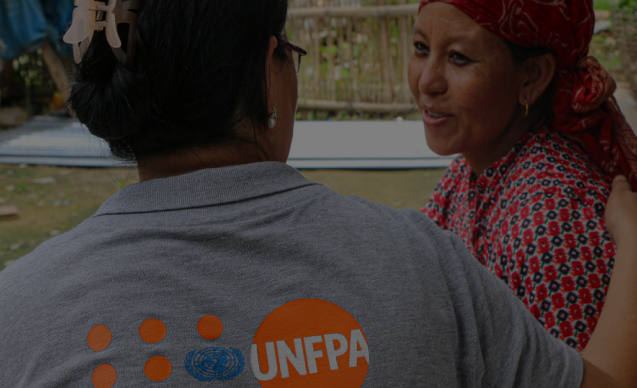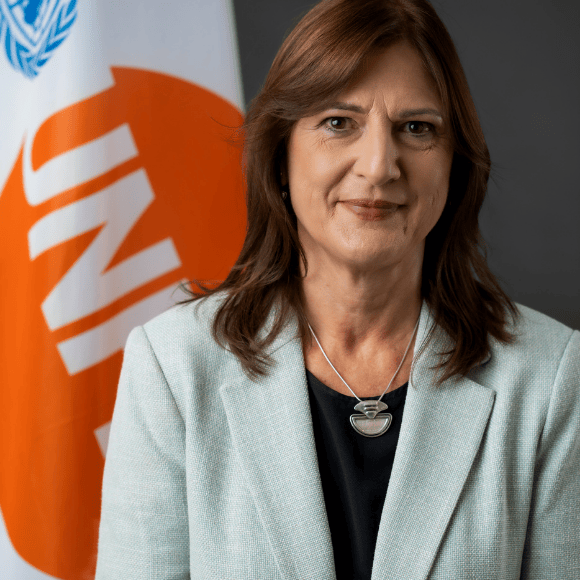General Overview
Our mission is to ensure that every pregnancy is wanted, every childbirth is safe, and every young person can fulfill their potential.

UNFPA, the United Nations Population Fund, helps women and young people live healthy and productive lives.
UNFPA is the lead UN agency working towards a world where:
- every pregnancy is wanted,
- every childbirth is safe,
- and every young person can reach their full potential.
We are making real progress. Since UNFPA began operations in 1969, the number and rate of women dying from pregnancy or childbirth-related complications has been cut in half. Families are smaller and healthier. Young people are more empowered and have more opportunities.
But there is still much work to be done. Nearly one billion people continue to live in extreme poverty. Reproductive health related problems remain among the leading causes of death and disability for women in developing countries. Young people face the highest risks of HIV infection and unplanned pregnancies. More than 100 million young women are at risk of early marriage, discrimination, and violence.
Guided by the Programme of Action adopted at the International Conference on Population and Development (ICPD) held in Cairo in 1994, and the Millennium Development Goals, UNFPA partners with governments, civil society, and other organizations to advance our mission. In February 2014, the Global Report ICPD Beyond 2014 was published, showing how much progress has been made and highlighting the critical work still ahead. The actions and recommendations in the report are key to achieving the goals of the ICPD Programme of Action and linking them to the post-2015 development agenda. See the 2013 UNFPA Annual Report.
In addition, UNFPA has structured its work around three transformative, people-centered results to be achieved by 2030. There are:
- zero unmet need for contraception;
- zero preventable maternal deaths;
- zero gender-based violence and harmful practices, such as child marriage and female genital mutilation.
UNFPA in Latin America and the Caribbean
Contributing to a world where every pregnancy is wanted
Few things have a greater impact on a woman’s life than the number and spacing of her children. For decades, international agreements have affirmed the right of individuals to freely decide whether or not to form a family, and how many children to have. These agreements have also supported the means to achieve those goals — such as access to quality services and supplies that enable people to exercise this right.
Greater access to safe, affordable, and effective contraceptives has led to more options and responsible decision-making around reproduction. Contraceptive use has also improved maternal and child health by preventing unwanted or closely spaced pregnancies. The contraceptive prevalence rate for any method is 74% in Latin America and 61% in the Caribbean. Modern contraceptive use is at 67%. It is estimated that the unmet need for family planning averages around 10%.
Maternal mortality fell by 40% in Latin America and 36% in the Caribbean between 1990 and 2013. However, approximately 9,300 women died from maternal causes in 2013. The maternal mortality ratio in the region was 85 deaths per 100,000 live births, considered “low” among developing regions. Meeting the unmet need for voluntary family planning could reduce maternal deaths by nearly one-third. This would greatly benefit the region, given that expanding contraceptive options as a part of basic healthcare reduces unplanned pregnancies.
UNFPA supports healthy families by:
- Training healthcare providers to offer quality family planning services.
- Supplying contraceptives in emergency situations
- Ensuring reproductive healthcare services tailored to youth
- Providing guidance and options for women who wish to avoid or delay pregnancy
- Educating men on the benefits of birth spacing
Make every birth safe
A woman’s lifetime risk of dying from maternal causes is 1 in 570 in Latin America and 1 in 220 in the Caribbean. We know how to save nearly every woman who dies while giving life. The first step is enabling women to plan their pregnancies and space them appropriately. Access to skilled care during childbirth, including emergency obstetric services and essential supplies, is also crucial. In Latin America and the Caribbean, 93.7% of births occur in health facilities, and it is estimated that 95% of pregnant women receive prenatal care.
Although maternal deaths are decreasing, pre-existing conditions are altering the global profile of maternal mortality. One in four maternal deaths is due to health conditions such as diabetes, HIV, malaria, and obesity, whose impacts can be worsened by pregnancy. These conditions account for 28% of global maternal deaths, followed by hemorrhages.
In Latin America and the Caribbean, maternal mortality is the leading cause of death among adolescent girls aged 15–19. The risk of infant death during the first year of life is also higher when the mother is an adolescent. The region also sees a significant number of unsafe abortions. Perhaps the greatest challenge to reducing maternal death and disability is reaching all women, especially those in poverty, remote areas, or in disaster and conflict zones. Achieving this requires strengthening health systems.
UNFPA works to improve maternal health by:
- Training midwives and healthcare providers
- Supplying aseptic birth kits in emergencies
- Strengthening emergency obstetric care
- Ensuring reliable supplies of reliable medicines and essential equipment
- Supporting birth spacing
And may every young person reach their full potential
People under the age of 25 make up 43 percent of the global population. In Latin America and the Caribbean, there are an estimated 140 million young people between 15 and 29. Several countries in the region are experiencing a “demographic dividend,” a period of increased youth population. This calls on policymakers and planners to implement strategies that boost youth potential, including programs improving access to decent jobs, education, and health services — especially sexual and reproductive health.
UNFPA in Latin America and the Caribbean champions the rights of young people, including their right to access accurate information and services related to sexuality and reproductive health. Empowered with knowledge and skills to protect themselves and make informed decisions, youth can realize their full potential and contribute to economic and social transformation.
The organization aims to promote, through technical and political advocacy, investment in opportunities that allow adolescents and youth to develop the knowledge, skills, and resilience needed for a healthy, productive, and fulfilling life.
Investing in youth — especially adolescent girls — is one of the smartest investments a country can make. As parents, teachers, and next generation leaders, young people can help break the cycle of poverty, strengthen social cohesion, and build a sustainable future.
UNFPA advocates for youth well-being by:
- Promoting human rights for adolescents
- Preventing HIV infection
- Involving youth in decisions that affect them
- Supporting age-appropriate comprehensive sexuality education
- Creating safe spaces for adolescent girls
- Advocating zero tolerance for violence against girls and women
- Promoting youth leadership
How We Work
UNFPA works to improve the lives of people in over 150 countries, which are home to 80% of the world’s population. In Latin America and the Caribbean, we have offices in 30 countries.
UNFPA acts as a catalyst for progress, working with governments and closely collaborating with other UN agencies, civil society, academia, faith-based organizations, and the private sector. We make a real difference in the lives of millions of people, especially the most vulnerable.
Our Regional Office in Panama City, Panama, and Subregional Office in Kingston, Jamaica, provide strategic support and technical advice to country offices. We offer technical cooperation, training, and support to empower our partners and field colleagues, ensuring that women's and youth reproductive health and rights are at the core of development.
To achieve this, we support the generation and use of population data to improve decision-making in public planning. We provide technical assistance to expand action opportunities in countries, advise on policies, and strengthen national capacities.
UNFPA is committed to solving tomorrow’s challenges today. We help countries use population data to assess and anticipate needs, as well as to monitor progress and identify gaps in fulfilling our commitments.
More Highlights
- UNFPA - Annual Report 2013 | Spanish | English
- International Conference on Population and Development – Beyond 2014
- Framework for Action to Follow-Up on the International Conference on Population and Development Beyond 2014 – Secretary-General’s Report | Spanish | English | French
- Global Report on the International Conference on Population and Development Beyond 2014 | Spanish | English | French
- Regional Conference on Population and Development in Latin America and the Caribbean – Montevideo Consensus | Spanish | English
- First Meeting of the Regional Conference on Population and Development in Latin America and the Caribbean
- UNFPA LACRO Position Paper on the ICPD Beyond 2014
- Millennium Development Goals and the Post-2015 Development Agenda




